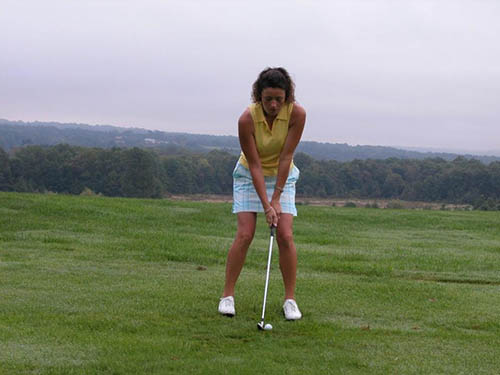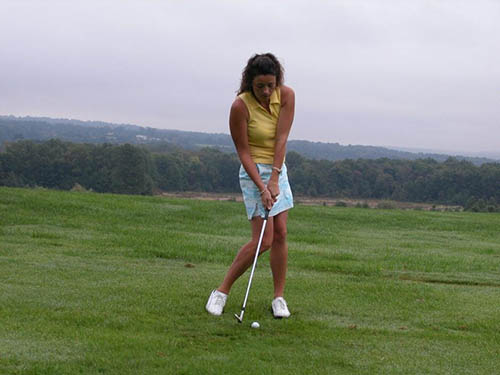Golf is a Game of Geometry

A Legacy Post by Keiser University College of Golf Senior Faculty and Director of Research Dr. T. J. Tomasi (1940-2023)
Golf is a game of geometry; so, to facilitate the rotary action of the swing, a key element is that the ball must be in the correct position at address.
What Kind of Mathematics are used in Golf?
In golf, various mathematical concepts are applied to improve performance and understand the game better. Geometry plays a crucial role in calculating distances, angles, and trajectories, helping golfers determine optimal shot placement and club selection. Trigonometry is used to analyze swing mechanics and ball flight characteristics, allowing golfers to adjust their technique for desired outcomes. Additionally, statistics and probability are employed to assess performance, evaluate risks, and make strategic decisions on the course. Overall, mathematics in golf enhances players’ abilities to navigate the course effectively and optimize their performance.
The setup of a golf shot is the process of making contact between the clubhead and the ball, emphasizing the importance of precise timing for impact. Furthermore, the position of the ball influences shoulder alignment and swing path, which in turn affects shot accuracy and trajectory.
One way to look at it is that all you’re really doing with your setup is arranging a collision, so that when your clubhead arrives at the appropriate point on the arc, the ball simply gets in its way. If the ball is somewhere other than the ideal position, impact will be mistimed, producing an off-line shot. Ball position also influences your shoulder alignment and, consequently, the path of your swing. Position the ball too far forward and your shoulders open, encouraging the out-to-in swing path characteristic of a slicer. Position the ball too far back and your shoulders close, which promotes the in-to-out path that facilitates a hook.
Golf Ball Placement
Ball placement in golf refers to the precise positioning of the golf ball in relation to the golfer’s stance and intended target line. It is a critical aspect of the setup for each shot, as it directly affects the angle of attack, launch angle, and ball flight trajectory. Proper ball placement allows golfers to optimize their impact conditions, resulting in improved distance, accuracy, and control over their shots. Additionally, variations in ball placement can influence the type of shot shape a golfer produces, providing strategic options to navigate around course obstacles.
To determine where to place the ball for each shot, make sure your head is positioned in the center of your body with your eye line parallel to the intended line of start. Since your head serves as a reference for correct ball position, you don’t want head-tilting to distort your view. In addition, correct eye alignment is important because there’s a tendency for the swing path to follow the eye line. Except for special ball flights, your hands should swing away parallel to your heel line; however, if you tilt your eye line to the right at address, the club travels too much inside during the takeaway. Those who tilt left often make the opposite error — an outside-the-line takeaway.
Golf Ball Position
Golf ball position refers to the golf ball’s placement in relation to the golfer’s stance and intended target line. It is a crucial aspect of the setup for each shot, as it directly influences the trajectory, distance, and accuracy of the ball flight. Math is used in golf ball position mainly to optimize the golfer’s impact conditions, considering factors such as swing path, clubface angle, and launch angle.
Mathematics comes into play when determining the optimal ball position for a given shot. Golfers use geometry to calculate the desired angle of attack and launch angle based on the club they are using and the desired ball flight. Trigonometry helps golfers understand the relationship between ball position, swing path, and clubface angle, allowing them to adjust their setup accordingly to produce the desired shot shape.
Furthermore, golfers rely on statistics and probability to analyze their performance and make strategic decisions about ball position. They may use data on their past shots, such as launch angle, spin rate, and carry distance, to identify patterns and trends that inform their ball position strategy on different types of shots and course conditions.
How important is ball position? I offer the case of Ralph Guldahl as an example. A very good player, Guldahl won several major championships in the 1930s and signed to write a book that included photography on every page. The problem was that the photographer didn’t understand golf, and he took the address shots at an angle that made it look as if the ball was too far back in Guldahl’s stance. After looking at the photo’s Guldahl moved the ball well-forward of his normal position and promptly lost his game. A few years later, no longer able to play at a high level, he retired and became a teaching pro.

Depending on the club you’re using, the ball is positioned somewhere between the middle of your stance and your lead shoulder. This player is using a pitching wedge, so the ball is placed back near the middle of her stance. With longer clubs, the ball position moves forward until you arrive at the driver which is played between the lead shoulder and lead heel.

It takes practice to find the right ball position at address and match it up with the desired ball flight. With a short iron and the ball in the middle of her stance, this golfer has her hands ahead of her clubhead at impact in order to strike with a descending blow. If she had positioned the ball off her left shoulder, she would take the ball with an ascending blow, which would be correct for a driver.
Learn more!
Want more tips? If you want to take your game to the next level, contact our team at Keiser University’s College of Golf & Sport Management today. With our dedication and experience, we can elevate your game to new heights together. Give us a call today at 888-355-4465.














